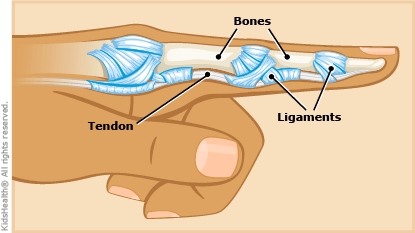A sprain happens when a ligament in the finger stretches or tears. Ligaments are stretchy bands that connect bones to each other. Finger sprains happen when the finger twists or bends back too far, usually from falling on an outstretched hand or catching a ball.
A sprain can be mild or severe. It can take a few days, weeks, or longer to feel better. To help a finger sprain heal, a health care provider usually puts a splint on the injured finger or tapes it to a neighboring finger ("buddy taping").
Follow these instructions to help your child as the sprain heals.




How are finger sprains diagnosed? Health care providers ask questions and examine the injured area. A sprained finger might be swollen, painful, stiff, or sore. The skin around the finger might look red or bruised. Sometimes they order X-rays to make sure there is no broken bone.
What can help prevent finger sprains? To prevent injuries to the fingers, encourage your child to: